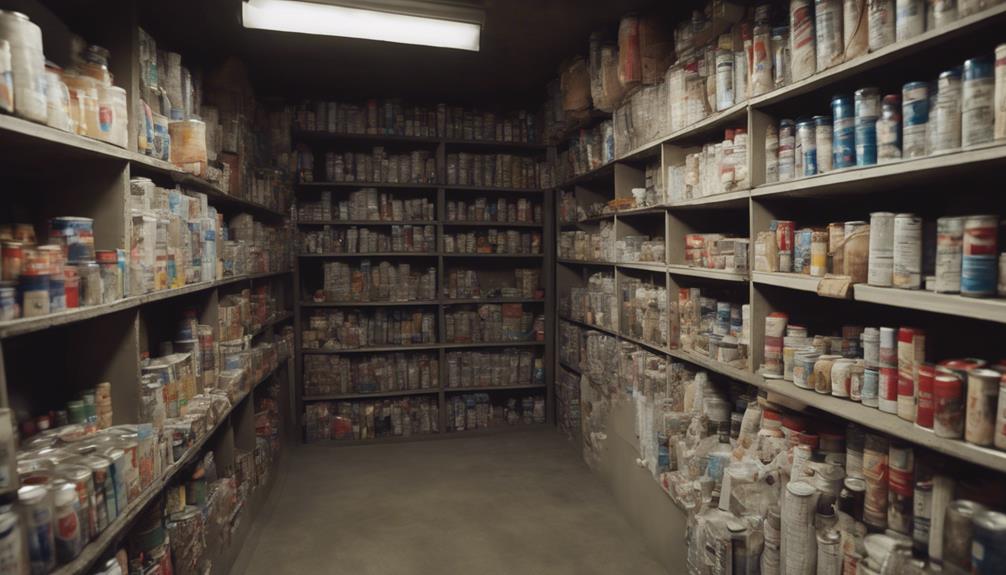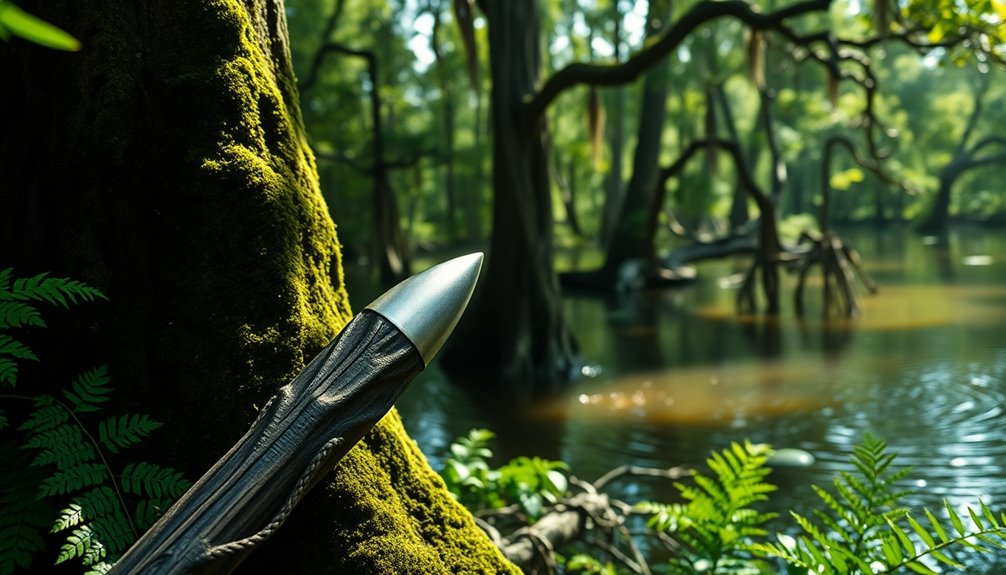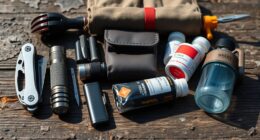Starting your prepping journey is all about building a solid foundation. Begin with an emergency kit, including two weeks' worth of non-perishable food and one gallon of water per person per day. Don't forget a first aid kit. As you expand, consider tradeable goods like hygiene products and ammunition. Equip yourself with essential tools, a portable stove, and a reliable communication device. Join local forums or training programs to connect with others and learn valuable skills. Remember, small steps today can lead to big survival gains tomorrow, and there's plenty more to explore for an extensive prepping strategy.
Key Takeaways
- Begin by assembling a basic emergency kit with essential supplies, including two weeks' worth of non-perishable food and water for each person.
- Focus on learning and practicing water purification methods, such as boiling or using purification tablets, to ensure safe drinking water.
- Invest in multi-tools and basic first aid supplies to handle various situations effectively and enhance your preparedness.
- Engage with local prepper groups or online forums to share knowledge, resources, and strategies for effective prepping.
- Start small by rotating your food and water supplies regularly to maintain freshness and avoid waste, ensuring you're always prepared.
Emergency Preparedness Essentials

Preparing for emergencies is vital for guaranteeing your safety and well-being during unexpected situations. You should start by assembling a thorough emergency kit that includes at least two weeks' worth of food and water. Aim for one gallon of water per person per day, covering drinking, cooking, and sanitation needs. Don't forget to take into account additional purification methods to guarantee your water's safety.
Your emergency kit should also contain a first aid kit stocked with essential medical supplies, as well as basic tools for repairs and self-sufficiency. Sanitation supplies are important, too, so include items like soap, hand sanitizer, and toilet paper to maintain personal hygiene during a crisis.
As you gather these supplies, keep an organized inventory to track what you have. This helps with meal planning and guarantees you can restock items before they expire.
Developing survival skills like basic first aid and food preservation techniques will further enhance your readiness. By focusing on these emergency preparedness essentials, you're taking significant steps to protect yourself and your loved ones when faced with unpredictable situations.
Protection Measures

When it comes to protection measures, having the right tools and knowledge can make all the difference in an emergency situation. Firearms and ammunition are essential for personal safety, especially when panic and desperation can arise quickly.
Consider investing in a biometric gun safe to store your firearms securely, allowing for quick access while keeping them safe from unauthorized users.
In addition to firearms, it's wise to explore non-lethal self-defense options like bear spray, particularly if you spend time outdoors. This can protect you from wildlife threats and provide an extra layer of security in emergencies.
Survivors of civil conflicts often highlight the importance of having self-defense tools and tradeable goods, like ammunition, which can enhance your survival tactics in prolonged crises.
To guarantee effective preparedness, develop a detailed protection plan that includes self-defense training and a solid understanding of local laws regarding firearms and safety equipment.
Water Supply Strategies

When prepping, you need to plan for your daily water needs, aiming for at least one gallon per person per day.
Proper storage solutions are key, so use food-grade containers and rotate your supply every six months.
Don't forget about purification methods; knowing how to make untreated water safe is essential for your survival.
Daily Water Needs
You need about 1 gallon of water per person each day to cover drinking, cooking, and hygiene needs, so it's vital to plan your water supply carefully. For a two-week emergency, that means storing at least 14 gallons of clean water per person. Remember, survival without water is limited to about three days, making adequate water storage and purification essential.
Here's a simple guide to help you manage your daily water needs:
| Water Supply | Storage Method | Purification Method |
|---|---|---|
| Emergency Water | Water barrels or containers | Water purification tablets |
| Stored Water | BPA-free plastic bottles | Filters (e.g., LifeStraw) |
| Additional Hydration | Electrolyte powders | Rainwater collection systems |
Regularly check and rotate your stored water every six months to maintain freshness and prevent contamination. As a beginner prepper, consider these hydration sources to help you stay hydrated during emergencies. By ensuring you have a solid plan for your daily water needs, you'll be better prepared to face unexpected challenges.
Storage Solutions
After confirming you've got your daily water needs covered, it's time to focus on effective storage solutions that will allow you to maintain a reliable water supply. Aim to store at least 1 gallon of water per person per day, totaling 14 gallons for a household of two.
Invest in food-grade water containers or barrels to preserve water quality; avoid using old chemical containers. You'll want to designate a storage space specifically for your water supply, keeping it separate from other prepping items like non-perishable food.
Rotate your water supply every six months to confirm freshness and label containers with expiration dates for easy tracking. Consider the extra cost of incorporating filtration systems or purification tablets to confirm safe drinking water when emergencies arise. Additionally, consider the benefits of using a HEPA filter to improve air quality in your storage area, which can help maintain the integrity of your supplies.
Additionally, think about collecting rainwater as a supplemental source for cooking and cleaning, confirming you're compliant with local regulations.
Joining a community of like-minded preppers can provide you with tips and strategies for efficient storage solutions. By organizing your water storage effectively, you'll enhance your overall food storage and preparedness strategy, giving you peace of mind during uncertain times.
Purification Methods
Guaranteeing access to clean drinking water during emergencies is essential, and knowing various purification methods can make all the difference.
Here are some effective strategies you can use:
- Boiling water: Heat water to a rolling boil for at least one minute. This method kills bacteria, viruses, and parasites.
- Water purification tablets: Use iodine or chlorine dioxide tablets to eliminate harmful microorganisms, making the water safe to drink.
- Filtration systems: Invest in portable filtration systems like LifeStraws or Berkey filters. These remove contaminants and are perfect for emergency situations.
- Rainwater collection: Collecting rainwater can be a viable water supply. However, always filter and purify it before consumption to guarantee it's safe.
Food Storage Techniques

When prepping, focus on stocking up non-perishable food options like canned meats, grains, and freeze-dried items for their long shelf life.
It's essential to monitor expiration dates regularly, so you can rotate your supplies and keep everything fresh. Additionally, a well-organized pantry can enhance mental well-being by creating a tidy environment that reduces stress during emergency situations.
Non-Perishable Food Options
Non-perishable food options are vital for any beginner prepper, as they provide a reliable source of nutrition during emergencies. Stockpiling a variety of non-perishable food items guarantees you're prepared for at least two weeks of potential challenges.
Aim for about 2,000 calories per person per day to meet your energy needs.
Here are some great non-perishable food options to take into account for your Emergency Food Supply:
- Canned goods (vegetables, meats, soups)
- Dried beans and lentils
- Rice and pasta
- Freeze-dried meals
Effective food storage techniques are key to extending the shelf life of your supplies. Utilize food-grade storage buckets and Mylar bags with oxygen absorbers to keep dry goods fresh. Consider adding juice cleanses to your diet, as they can provide essential nutrients during an emergency situation.
Don't forget to incorporate comfort foods, like snacks and treats, to help maintain morale during tough times.
Remember, it's important to rotate your food supply every 6 to 12 months to prevent spoilage and minimize waste.
With these strategies in place, you'll have a solid foundation of shelf-stable food to support your preparedness journey.
Expiration Date Monitoring
Monitoring expiration dates is vital for maintaining the safety and quality of your food supplies. Regularly check the expiration dates on all items in your stockpile, as many non-perishable foods can lose quality or become unsafe after their labeled shelf life.
To simplify monitoring, consider using an inventory app or a spreadsheet to track your food items, purchase dates, and expiration dates.
Organizing your food storage by grouping items based on their expiration dates is important. Place those with the nearest expiration at the front, making sure you use them first. Remember to rotate your food stock at least every six months. This practice helps you replace expired items and keep your supplies fresh.
For long-term food storage, using oxygen absorbers and vacuum-sealing techniques can extend shelf life while maintaining quality. However, even with these methods, you still must keep an eye on expiration dates.
Tradeable Goods Importance

In times of crisis, the importance of tradeable goods can't be overstated. Stockpiling these items can provide you with essential resources for bartering when traditional currency may lose its value.
By having a diverse inventory of tradeable goods, you enhance not just your preparedness plan, but also the community resilience around you.
- Ammunition
- Non-perishable food
- Hygiene products
- Gasoline
Items like lighters and alcohol can become highly sought-after commodities, facilitating trade among community members for survival essentials.
Survivors of civil conflicts have shared that possessing tradeable goods greatly improves personal safety and access to necessary supplies when external support is unavailable.
Understanding the value of tradeable goods and actively accumulating them can be a strategic component of your preparedness plan.
You never know when a simple item might become the key to securing emergency supplies or meeting your neighbor's needs.
Essential Tools and Gear

Having the right vital tools and gear can make all the difference in your preparedness efforts. As a beginner, focus on gathering items that enhance your survival capabilities during emergencies. Here are some must-have tools to take into account:
| Vital Tool | Purpose | Notes |
|---|---|---|
| Multi-tool | Versatile tool for various tasks | Includes knife, screwdriver, etc. |
| First Aid Kit | Basic medical supplies for injuries | Include bandages and antiseptics |
| Water Purification Tools | Guarantee clean drinking water | LifeStraws or purification tablets |
| Portable Propane Camping Stove | Reliable cooking method without power supply | Don't forget extra propane! |
Additionally, a sturdy axe is essential for chopping wood, and a reliable flashlight guarantees visibility in dark situations. Organizing important documents, like copies of IDs and medical information, in a waterproof container is vital for quick access during evacuations. Combine these items into your survival kit, and you'll be well-prepared to handle unexpected situations. Start small, and build your collection over time, making sure you're ready for whatever comes your way!
Consider including portable camping toilets to improve sanitation during extended outdoor stays, which is crucial for maintaining hygiene in emergency scenarios.
Communication and Power Needs

Prepping List for Beginners: Start Small, Survive Big!
Communication and Power Needs
Staying informed and powered up during emergencies is just as important as having the right tools and gear. You need reliable communication and power sources to navigate unexpected situations effectively. Here's a quick checklist to help you prepare:
- NOAA weather radio or two-way ham radio for emergency updates
- Spare batteries and solar chargers to keep devices running
- Indoor-safe heating options for comfort during outages
- Vehicle preparedness kit for road emergencies
Start by acquiring a NOAA weather radio or a two-way ham radio to guarantee you receive emergency updates when traditional communication fails. Stock up on spare batteries and consider solar chargers to maintain power independence. Additionally, ensure your vehicle is equipped with a vehicle preparedness kit that includes essential items like a first aid kit and extra water.
Don't overlook sanitation; keep wet wipes, hand sanitizers, and camp soap handy to manage hygiene without running water. Furthermore, confirm you have heating options like extra blankets and portable fans to adapt to temperature changes during power outages.
Finally, create a vehicle preparedness kit that includes essential gear for road emergencies, such as an IFAK, extra prescription medications, and a USB charger adapter for your car. Being proactive about these communication and power needs can make all the difference in an emergency.
Skills and Community Involvement

Building skills and engaging with your community can greatly enhance your emergency preparedness. When you connect with others, you tap into a wealth of shared resources, knowledge, and skills that bolster effective prepping.
Consider participating in local meet-ups or online prepper forums, where you can network with like-minded preppers. These gatherings offer invaluable opportunities to learn from each other's experiences and strategies.
Emergency response training, such as Community Emergency Response Team (CERT) courses, equips you with essential skills to handle crises. Not only do you learn life-saving techniques, but you also cultivate teamwork, which is vital during emergencies.
Volunteering for community initiatives related to emergency preparedness can further enhance your skills while contributing to your community's overall safety and resilience. Additionally, engaging in local programs that focus on financial considerations for elderly care can provide crucial support for vulnerable populations during emergencies.
Don't forget to regularly share preparedness tips with family and friends. This practice not only strengthens your personal health and readiness but also fosters collective resilience in the face of challenges.
Frequently Asked Questions
What Are the Top 10 Food Items for Preppers?
When considering the top food items for preppers, you'll want to focus on long-lasting, nutritious options.
Canned goods like beans and vegetables are crucial, while rice and pasta provide versatile, non-perishable carbs.
Don't overlook freeze-dried meals for convenience.
Peanut butter packs a protein punch, and dehydrated fruits and veggies add essential nutrients.
Stocking these items guarantees you're prepared for any situation, keeping your energy up and your meals satisfying.
What Is the First Thing a Prepper Should Do?
The first thing you should do as a prepper is create a detailed list of essential supplies tailored to your needs.
Start by prioritizing food, water, first aid, and tools. Aim for at least two weeks' worth of non-perishable food and 14 gallons of clean drinking water—one gallon per person per day.
Organizing your inventory helps keep track of supplies and guarantees you're prepared for any situation that arises.
What Is the 30 Day Prepping List?
The 30-day prepping list helps you accumulate supplies, build skills, and enhance your preparedness.
Each day, you focus on specific tasks like inventorying supplies, acquiring non-perishable food, and assembling a first aid kit.
You'll aim to stock at least two weeks' worth of food and water, ensuring you have essentials covered.
How to Prepare for a Doomsday List?
To prepare for a doomsday scenario, start by identifying potential threats in your area, like natural disasters.
Accumulate at least two weeks' worth of non-perishable food and 14 gallons of clean drinking water.
Include essential gear such as first aid kits, multi-tools, and flashlights.
Don't forget communication devices for emergency updates.
Regularly check your supplies, rotate items, and replace anything expired to guarantee you're always ready for whatever comes your way.
Conclusion
You might feel overwhelmed by the idea of prepping, but remember, starting small can lead to survival big. Just like a single drop of water can create ripples, each small step you take in emergency preparedness makes a difference. Equip yourself with essential tools, stockpile food, and build community connections. While the world can be unpredictable, your proactive choices today can turn uncertainty into security. Embrace the journey, and you’ll find strength in simplicity and resilience in preparation. Don’t be discouraged by the daunting task of preparing for emergencies. Focus on acquiring the prepper essentials, such as first aid supplies, water purification methods, and a reliable communication plan. By gradually building up your emergency kit and honing your skills, you’ll be better equipped to face any future challenges with confidence and peace of mind. Remember, taking small steps now can lead to big rewards in the event of an emergency.










